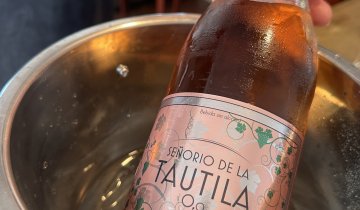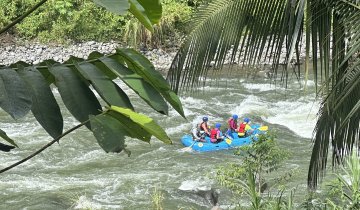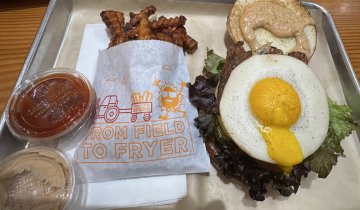While researching the upcoming 2012 edition of Vegetarian Asia: A Travel Guide, I had the good fortune to meet Angela Dollar online. She shared her experiences about vegetarian travel in Laos. Angela writes a sustainable travel blog called Travel with a Purpose. Here’s our interview:
Teresa: When did you visit Laos and where did you go?
Angela: I visited Laos several times between 2003 and 2006. Besides spending a good amount of time in Luang Prabang andVientiane, I’ve been through the south (Pakse, Savannakhet, Chompasak, Si Phan Don (Don Det and Don Khong) as well as several small villages in the north including Nong Khiaw, Luang Nam Tha, Udomxai, and Vang Vieng.
Teresa: How hard was it to find vegetarian food? And to express your wishes for vegetarian food?
Angela: It was fairly easy to find in the cities of Vientiane and Luang Prabang, as well as the tourist ghetto of Vang Vieng, but it became harder once you were out of these little enclaves. We learned a few Lao phrases right off the bat to make sure we could get by…things like “baw kin sin,” meaning “I don’t eat meat.” Often the best tactic was to know a handful of dishes we could ask for by name that were always prepared vegetarian.
Teresa: How do you think Lao people regard vegetarians?
Angela: As with so many cultures, many Lao communities have now had contact with Western tourists, so if nothing else it may be less surprising for them. That said, culturally they eat meat on a very regular basis and it stands as a cornerstone in their diet. Without having the language skills to have a comprehensive conversation on the topic, I haven’t had the luxury of picking their brains on this Western practice.
Teresa: What were your favorite Lao dishes?
Angela: I’m obsessed with the simple fresh rolls you can get virtually anywhere inLaos, particularly those sold at the Luang Prabang night market. I also adore jaew mak khua, an eggplant-based dip with fresh herbs and chilies that people eat with the Lao staple, khao niao (sticky rice). Omelets became my protein go-to item, and the eggs were always so local and so fresh that they beat the socks off of any I’d make at home. I found tasty laap made with tofu in a few places, and the Lao version of pho soup was easy enough to get in a vegetarian form and very tasty. Oh! And the Lao coffee was heaven on earth, how could I forget?
Teresa: Do you have any memorable food-related moments fromLaos?
Angela: Sitting at a local coffee stop, day after day, watching the world go by and sipping lao coffee is one of the sweetest. (Here’s a post I wrote about it) Also, a local family invited me to what amounted to a “Lao wake” for their grandfather who had passed away – a great honor. At the celebration dinner, a python that had been captured in the woods was made into a soup and ceremoniously shared. Offered with such sincerity and reverence, I had to at least take a taste to show good face. It was… memorable!
I also remember that some of the BEST Indian food I’ve ever had was at the Nazim’s chain in Laos. The one on the main drag in Luang Prabang is the best in my opinion. Indian food is a vegetarian’s savior!
Teresa: What do you think is the general Lao attitude toward animals? Any pets?
Angela: Like so much of the developing world, it seems that Lao people regard animals as a commodity more than anything. I rode in many a bus with a sack of chicken at my feet and saw pigs tied down and squealing on the backs of songthaews. It can be a challenge to witness for anyone who is sensitive to animals and suffering, but it serves as a reality check for the perspective of a culture where animal husbandry is part of everyday life, unlike ours.
I saw a few cats being kept as pets, and noticed that the monks in the temples often fed the street dogs and cats, but overall my sense is that this is not a pet-keeping nation in general. As the overall prosperity of the nation rises, I won’t be surprised if we do start seeing more domestic animals as pets in Lao peoples’ homes. In neighboring Thailand, the King’s public affection for his pet dogs has led to a boom in puppy-ownership.
Teresa: Any advice for vegetarian travelers to Laos?
Angela: Learn some vital phrases in the Lao language, and keep a cheat sheet handy while you travel. Things like, “Does this have meat?” and “I don’t eat meat” are vital to know how to say! Also, learn the Lao names for a few dishes that are traditionally made vegetarian. You can ask for these dishes by name when you are confronted with an all-meat menu and if they are common dishes then you’ll likely be able to have it prepared for you. Carry lots of vegetarian snacks, especially with protein, to supplement as needed or to tide you over a few hours on a bus ride through the hills. Finally, be on the lookout for alternate cuisines that can help round out your veggie diet – Indian food is a sure bet, as are the numerous French-influenced cafes in the larger cities.





Some of the popular routes covered by this program include Bangkok to Maldives, Samui, or Luang Prabang in Laos.